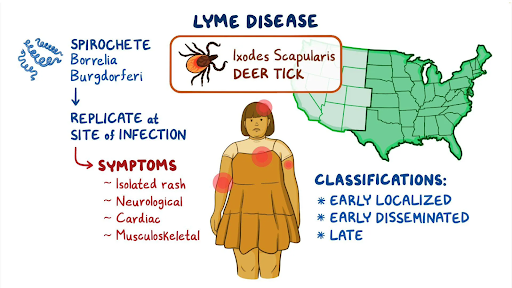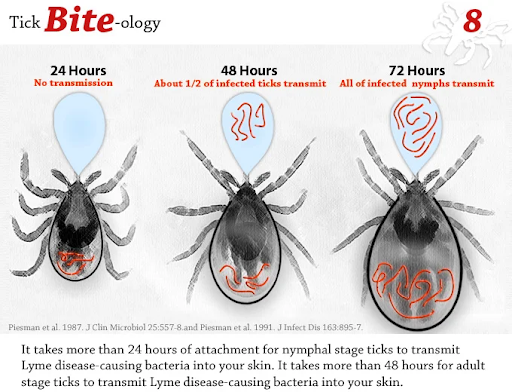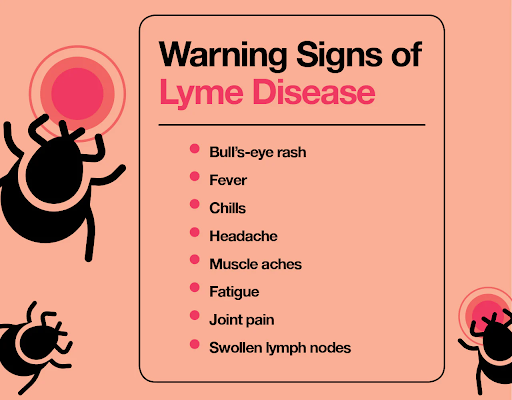
Ticks are the major cause of Lyme disease, one of the most common tick-borne diseases caused by the bacterium Borrelia burgdorferi.
When people are engaged in outdoor activities, the chances are more to get exposed. Learning about the lyme condition and the areas where people get more exposed to such diseases can help to prevent it.
This blog will aim to explain the science behind the tick-borne disease transmission and show how these tiny creatures can pass on the bacteria. By understanding how Lyme disease spreads, we can better protect ourselves from this serious illness.
How do ticks transmit Lyme disease to humans?
- Ticks transmit Lyme disease by injecting Borrelia burgdorferi bacteria into the bloodstream during a bite.
- After feeding blood from an infected animal, a tick becomes a carrier of Borrelia burgdorferi, the bacterium responsible for Lyme disease.
- Once a tick burrows into a human, it injects saliva that may contain the bacteria into the blood.
- This spreads the bacteria through the body and can disseminate the infection throughout several tissues.
- The transmission of Lyme disease typically requires at least 24-48 hours of attachment from the tick.
Therefore, the removal of ticks within a short time after exposure will prevent the bacteria from entering the bloodstream. Early detection and removal of ticks greatly reduce the chances of infection.

What is the role of Borrelia burgdorferi in Lyme disease transmission?
The role of Borrelia burgdorferi in Lyme disease transmission is to infect humans through tick saliva during feeding, causing illness.
- When a tick feeds on an infected animal, it picks up the bacteria Borrelia burgdorferi, which multiply in its gut. The bacteria then move to the tick’s salivary glands. When the tick bites a human or animal, it injects saliva containing the bacteria into the host’s bloodstream, spreading the infection.
- The bacteria can move throughout the bloodstream and impact several systems including the skin, joints, and nervous system, bringing about the symptoms that describe Lyme disease.
- Without the proper treatment, Borrelia burgdorferi may lead to lifelong health issues, hence it is crucial to understand the role of the bacteria to prevent it.

How long does a tick need to feed to transmit Lyme disease?
- The tick needs to be fed for 24 to 48 hours to transmit Lyme disease bacteria called Borrelia burgdorferi into the host’s bloodstream and cause Lyme disease.
- The feeding period during which the tick injects saliva into the host’s bloodstream enables the bacteria to penetrate and start infecting the body. The longer the tick remains attached, the higher the chance of bacteria being transmitted.
- Usually, the danger of being infected increases exponentially after the lapse of 36 hours after attachment. For this reason, it is important to inspect ticks attached to an individual after some outdoor activity and remove them immediately. Ticks are removed easily if the removal time occurs within 24 hours of attachment.
What are the symptoms of Lyme disease after a tick bite?
- After a tick bite, symptoms of Lyme disease typically appear 3-30 days later. The most common early symptom is a characteristic bull’s-eye rash, which appears at the site of the tick bite. Other early symptoms include fever, chills, headache, fatigue, muscle aches, and swollen lymph nodes.
- If left untreated, the disease can progress to affect the joints, heart, and nervous system. In later stages, patients may experience arthritis, particularly in the knees, and neurological issues like facial paralysis or heart irregularities.
- Early diagnosis and treatment with antibiotics are critical for preventing long-term complications. Recognizing these symptoms early on can help ensure effective treatment and reduce the risk of chronic Lyme disease.

How to prevent Lyme disease from tick bites?
- To prevent Lyme disease from tick bites, reduce your exposure to ticks in greens, bushes, and woody areas. Do regular checks for ticks and wear long sleeves, pants, and tuck pants into socks while you are outdoors to reduce tick access.
- Use tick repellents such as applying permethrin to clothing, and DEET to exposed skin, walk on cleared paths, and avoid getting inside tall grasses where ticks are commonly found. After being outdoors, carefully check for ticks on your body, including underarms, behind the knees, and in hair.
- if a tick is found, remove it immediately using fine-tipped tweezers, pulling straight out without twisting. The quicker the tick is removed, the lower the risk of Lyme disease transmission.
Conclusion
Ticks are responsible for transmitting Lyme disease, a potentially debilitating illness. Awareness of how Lyme disease is spread, along with preventive measures, can significantly reduce the risks associated with tick-borne diseases. Taking steps to avoid tick bites is essential for protecting your health.
Reference
- Alliance GL. About Lyme – Global Lyme Alliance. www.global lyme alliance.org. 2023. [GLA]
- CDC. Signs and Symptoms of Untreated Lyme Disease [Internet]. Lyme Disease. 2024. Available from: [CDC]
- Bahadori A, Ritz N, Zimmermann P. Diagnosis and treatment of Lyme disease in children. Archives of Disease in Childhood Education and Practice Edition. 2023 Dec 1;108(6):422–8. [PubMed]
- How to Treat Lyme Disease: A Patient Reflects. Globallymealliance.org. 2024 [cited 2025 May 12].







